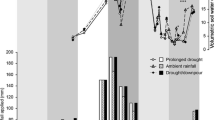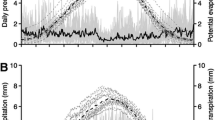Summary
Recent climate change scenarios resulting from elevated trace gasses may alter environmental temperature and moisture. The ecological consequences, however, are uncertain requiring an understanding of how soil-plant systems will respond to different conditions. This study examines the temporal characteristics of soil water retention in a temperate grassland following natural and simulated summer showers. We have used weighting lysimeters located in grassland stands of 360 m2, 2.25 m2 and lone lysimeters measuring 0.07 m2. Water deposited from natural summer rainfall on these grasslands is likely to be lost in less than two days because 92% of the rainshowers are < 10 mm having residence times of less than two days. Showers > 10 mm did, however, consistently remain in the soil-plant system for periods longer than light showers. When the largest plots (360 m2) were wetted by small (< 3 mm) natural rainfall events covering a portion of the entire valley (30–70 km2), soil water depletion rates were not significantly different than if just the 360 m2 plots were wetted by irrigations of the same size. If anthopogenetic changes occur in the rainfall amounts of summer showers in the Northern Great Plains, our results support the contention that soil water retention and associated ecosystem processes may be significantly altered inAgropyron smithii (Rybd.) grasslands.
Similar content being viewed by others
References
Ares, J., 1976: Dynamics of the root system of blue grama.J. Range Management 29, 208–213.
Bailey, H. P., 1979: Semi-arid climates: Their definition and distribution. In: Hall, A. E., Cannell, G. H., Lawton, H. W. (eds.) Agriculture in semi-arid environments. Springer: New York U.S.A., pp. 73–96.
Boatman, J. L., Super, A., Holroyd, E., 1977: Summer rainstorm types and associated rainfall characteristics in eastern Montana. Sixth conference of planned and inadvertant weather modification, Champaign-Urbana, Illinois, October 1977, 327–330 p.
Collins, D., Weaver, T., 1978: Effects of summer modification (irrigation) in Festuca idahoensis-Agropyron spicatum grasslands.J. Range Management 31, 264–269.
Coupland, R. T., 1950: Ecology of mixed prairie in Canada.Ecol. Monogr. 20, 271–315.
Emanuel, W. R., Shugart, H. H., Stevenson, M. P., 1985: Climate change and scale distribution of terrestrial ecosystem complexes.Climate Change 7, 457–460.
Hansen, J., Fung, I., Lacis, A., Rind, D., Lebedeff, S., Ruedy, R., Russel, G., 1988: Global climate changes as forecast by GISS's three-dimensional model.J. Geophys. Res. 93, 9341–9364.
Heimbach, J., Super, A. L., 1980: Raingage network requirements from a simulated covective complex weather modification experiment.J. Appl. Meteor. 19, 1176–1183.
Hinds, W., 1973: Small lysimeters for measurement of water use and herbage yield.J. Range Management 26, 304–306.
Karl, T. R., Heim, R. R., Quayle, R. G., 1991: The greenhouse effect in Central North America: If not now, when?Science, 251, 1058–1061.
Kendrew, W. G., 1953: The climates of the continents. Oxford University Press, Amen House: London, 607 p.
Kuchler, A., 1964: Potential natural vegetation of the conterminous United Stated. Amer. Geogr. Soc. Special Publication # 36. New York 154 p and map.
Lauenroth, W. K., Dodd, J. L., Sims, P. L., 1978: The effects of water and nitrogen-induced stresses on plant community structure in a semi-arid grassland.Oecologia 36, 211–222.
Lauenroth, W. K., 1979: Grassland primary production: North American grasslands in perspective. In: French, N. R. (ed): Perspectives in grassland ecology. Springer: New York, U.S.A., pp 2–24.
National Academy of Sciences, 1983: Changing climate. Report of the Carbon Dioxide assessment committee. National Academy Press: Washington DC, U.S.A.
Newbauer, J., White, L., Moy, R., Perry, D., 1980: Effects of increased rainfall on native forage production in eastern Montana.J. Range Management 33, 246–250.
Pastor, J., Post, W. W., 1988: Responses of northern forest to CO2-induced climate change.Nature 334, 55–58.
Perry, D., 1976: Effects of weather modification on northern great plains grasslands: A preliminary assessment.J. Range Management 29, 272–278.
Ramanathan, V., 1988: The greenhouse theory of climate change: A test by an inadvertent global experiment.Science 240, 293–299.
Risser, P. G., 1988: Abiotic controls on primary productivity and nutrient cycles in North American Grasslands. In: Pomeroy, L. R., Alberts, J. J. (eds.)Concepts of Ecosystem Ecology, Ecological Studies, #67. Springer: New York, U.S.A., pp. 115–130.
Rogowski, A., Jocoby, E., 1977: Assessment of water loss patterns with microlysimeters.Agron. J. 69, 419–424.
Sala, O. E., Lauenroth, W. K., 1982: Small rainfall events: an ecological role in semiarid regions.Oecologia 53, 301–304.
Schimel, D. S., Parton, W. J., Kittel, T. G. F., Ojima, D. S., Cole, C. V., 1990: Grassland biogeochemistry: links to atmospheric processes.Climate Change 17, 13–25.
Schneider, S. H., 1989: The greenhouse effect: Science and policy.Science 243, 771–780.
Smith, R. E., Schreiber, H. A., 1974: Point processes of seasonal thunderstorm rainfall. 2. Rainfall depth probabilities.Water Res. Research 10, 418–426.
Smoliak, S., 1956: Influence of climatic conditions on forage production of shortgrass rangeland.J. Range Management 9, 89–91.
USDA. 1977–1981: Climatological data. NOAA Environment Data and Information Service. Ashville, NC.
Vinnikov, K. Ya., Groisman, P. Ya., Lugina, K. M., 1990: Emperical data on contemporary global climate changes (Temperature and Precipitation).J. Climate 3, 662–677.
Weaver, T., 1980: Climates of vegetation types of the northern Rocky Mountains and adjacent plains.American Midland Naturalist 103, 392–398.
Weaver, T., 1982: Distribution of root biomass in welldrained surface soils.American Midland Naturalist 107, 393–395.
Weaver, T., 1985: Summer showers: their sizes and interception by surface soils.American Midland Naturalist 114, 409–413.
Weaver, T., Johnson, C., 1983: Plant responses to single showers in the dry summer season.Agropyron smithii. In: Holman, L., Knudsen, G. (eds) State of Montana activities in the high plains cooperative program, 1981–1983. Montana Dept. of Natural Resources and Conservation, Helena, MT, U.S.A.
Author information
Authors and Affiliations
Additional information
With 1 Figure
Rights and permissions
About this article
Cite this article
Welker, J.M., McClelland, S. & Weaver, T. Soil water retention after natural and simulated rainfall on a temperate grassland. Theor Appl Climatol 44, 229–237 (1991). https://doi.org/10.1007/BF00868178
Received:
Revised:
Issue Date:
DOI: https://doi.org/10.1007/BF00868178




